Culture // May 2023
Meet the Artists
As 101 Collins Street unveils the first stage of its lobby evolution, One Hundred and One meets Jose Dávila and Andrew Hazewinkel – two of the five artists whose large-scale works grace the space – and the curator who brought them together.
With acclaimed postmodern interiors by American architect John Burgee, expansive proportions and elaborate materials such as veined marble and gold leaf, the 101 Collins Street lobby offers an unmatched level of elegance within a Melbourne icon. As part of the major refurbishment by Bates Smart, a commissioned suite of permanent public artworks responds to the reimagined vision for the space, through finishes to be slowly unveiled, adding weight and cultural significance to the everyday arrival experience for our customers and visitors.
“Part of our mission is to make the lobby a more inspiring and interactive space, one that encourages people to stop, gather and socialise”, says 101 Collins Street General Manager Peter Calwell. “Art plays an important role in this as it leads to connection, emotional contemplation, and reflects 101 Collins’ history as a keen contributor to Melbourne’s art community.”
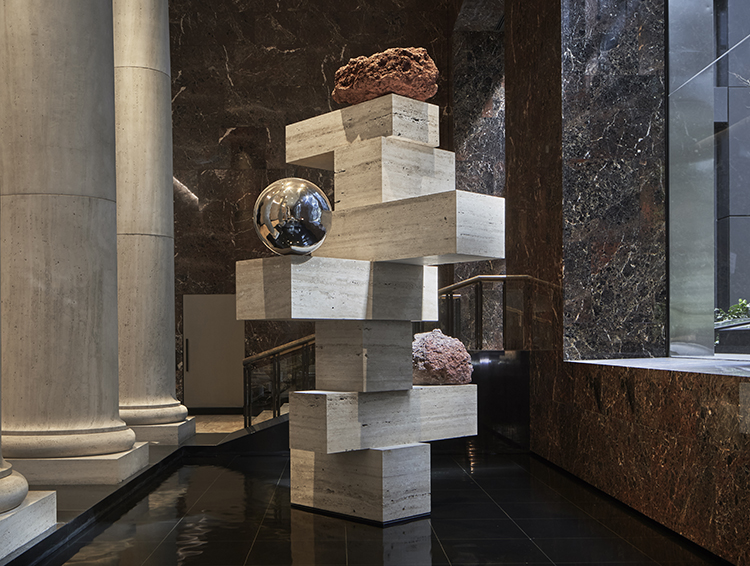
For Curator Emily Cormack, who specialises in how art affects the body of the viewer, particularly within public spaces, the opportunity to commission artworks for what she describes as “some of the most architecturally compelling gallery spaces in the city”, was thrilling. “I want to ensure that the work I commission generates unexpected, enlivening and affecting encounters with contemporary art”, she explains. “I feel that being around art has very real benefits for everyone, and so I try to curate exhibitions and commission works that activate the viewer – sensorially, intellectually or emotionally.”
In her curatorial approach to the commission process, Emily highlighted how the lobby of 101 Collins “traverses from the elegance of Collins Street’s ‘Paris End’ to the dynamic vibrancy of Flinders Lane – a centre for galleries, dining and street art.” This passage from “rarefied affluence to edgy dynamism” called for each area of the lobby to be broken into zones that “spoke to the material energies specific to that location”.
“The briefs requested that the artists think through specific qualities of material, activity and essence”, explains Emily. “In the central core of the lobby, artists were invited to respond to the contrast between the weight of the marble, the light-reflective nature of the gold leaf in the Collins Street entrance, and the reflective pool that sits within.”
With the briefs set, Emily dug deep researching artists who would capture the vision for the space, casting her net far and wide. Mexican artist Jose Dávila, whose work is highly acclaimed internationally, responded immediately to the material forces of the space as expressed in the brief, as did Athens-based Melburnian Andrew Hazewinkel.
Jose Dávila and Andrew Hazewinkel are the first two artists to be exhibited in the new 101 Collins Street lobby (a total of five artists will be exhibited once the lobby is complete). Both responding to the qualities of the space in distinct and compelling ways, Andrew’s two large-scale sculptures are installed in the new Sanctuary Garden, while Jose’s works are in the East Lounge Pool area, interacting directly with the pool while linking to the outside space through a series of glass walls.
Known for his sculptural three-dimensional works that focus on interacting with people and creating a link with the viewer, Jose is interested in making people feel present and aware of their surroundings. Here, he has created two sculptures that respond to the “pure mass, gravitas and columns”, working with the overall language of the 101 Collins space yet strong in their own presence.
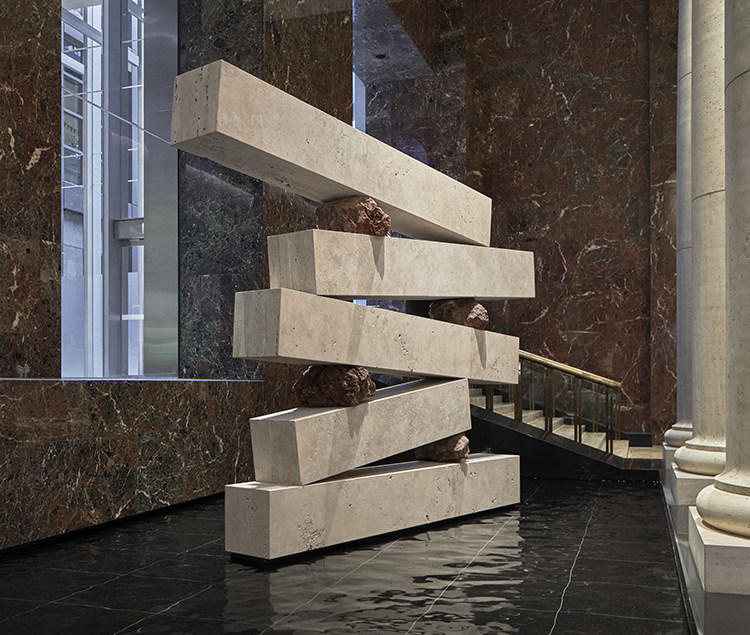
The two totem-like sculptures use the same materials – travertine marble volumes, raw volcanic rocks and a mirror-finished metal sphere –one balanced vertically, the other occupying space horizontally. “They are simple compositions, almost like a game of Jenga”, explains Jose. “It’s human nature to organise things in the simplest way, so there’s no complex narrative; I want it to be easy for people to have an emotional connection.”
The sphere and cube as platonic volumes illustrate how forces are exchanged, weight is distributed, and gravity is confronted. “One could say that humans have tipped the world out of balance and a joint effort is constantly needed to retain the fragile balance of our society. So, these works are simple, easily recognisable and yet also have a narrative that gives them a gravitas both in their materiality and as reminders of how society should function.”
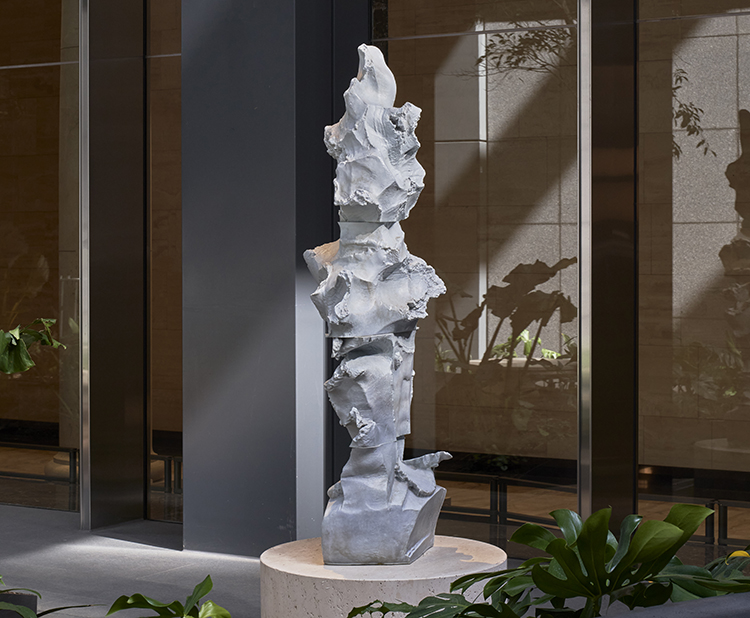
In the Sanctuary Garden, Andrew Hazewinkel’s two-part whitened bronze sculpture The Sisters (sibyls of transformation) is based on his long engagement with the histories of figurative sculpture, archaeological practices and approaches to restoration. Andrew is also interested in the ways in which ancient sculpture is transformed through long exposure to the natural elements. Andrew, who lives in Athens but grew up in Melbourne, where he studied sculpture at Victorian College of the Arts, has long been aware of the temple-like spatial qualities of 101 Collins Street’s post-modern architecture which echoes the classical with a powerful resonance.
At once graceful and elegant, strong and stable, Andrew’s part caryatid, part reassembled column-like figures began their journey as hand built 25cm high clay figures in his Athens studio. These small figures were then scanned in three dimensions at extremely high resolution, using a gem scanner, enabling them to be scaled up to almost two meters high without losing any of their exquisite detail. Andrew then digitally manipulated those files. Firstly he digitally separated each of the figures into four sections which he then reassembled using a strategy of intentional misalignment, by doing so he obliquely refers to the sometimes far from perfect restoration attempts.
Once he was happy with the digitally reassembled figures, he saved each figure’s four component parts as individual files which then re-entered the physical world by being machine-cut and hand-finished, becoming the ‘positives’ from which moulds were made enabling the bronze casting processes to begin. The casting and ‘reassembly’ processes culminated with the two completed human-scaled bronze figures being ‘finished’ with a whitish patina of bismuth nitrate. This delicately veiling and revealing patina was applied to most of the enigmatic bronze surfaces, leaving each of the figures with only one highly polished, mirror-like section that reflects each of The Sisters’ surroundings and the viewer that moves around them.
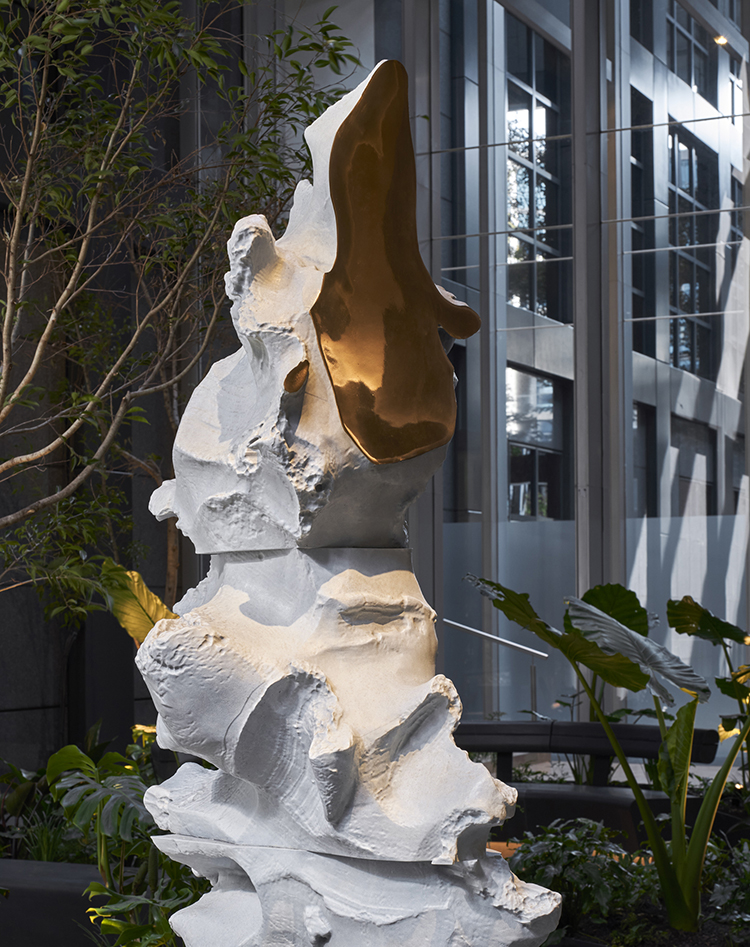
“If you look closely, you can see super-size thumb prints of the artist in their exquisite texture”, says Emily, “which is contrasted by the highly reflective, smooth syrupy bronze.”
According to Andrew, “the visual dialogue between the white patinated bronze surfaces and the highly polished reflective bronze surfaces refer to the building’s existing material themes of matte and shiny. They express a sensitive association with the monumental gold-leafed volumes of the interior, seamlessly linking the interiors and the Sanctuary Garden though experience and materiality.”
Standing on repurposed travertine bases carefully removed from the original columns on the lobby’s west side, Andrew’s sculptures radiate both dignity and calmness, utterly in keeping with the meditative overtones of the Sanctuary Garden, which offers people a chance to escape and reflect.
For Emily, this is the very essence of what art in the workplace can do. “Art also shows us that we are more than commodities, reminding us of the very human ability to think deeply, imagine and question, beyond our task-focused everyday realities,” she explains. “It invites us to understand another’s way of being, and to be confronted with our own, so that we might connect more effectively with each other.”
Jose Dávila and Andrew Hazewinkel’s works are on display in the newly refurbished East Lounge area of the 101 Collins Street lobby.
Share this on LinkedIn, Twitter
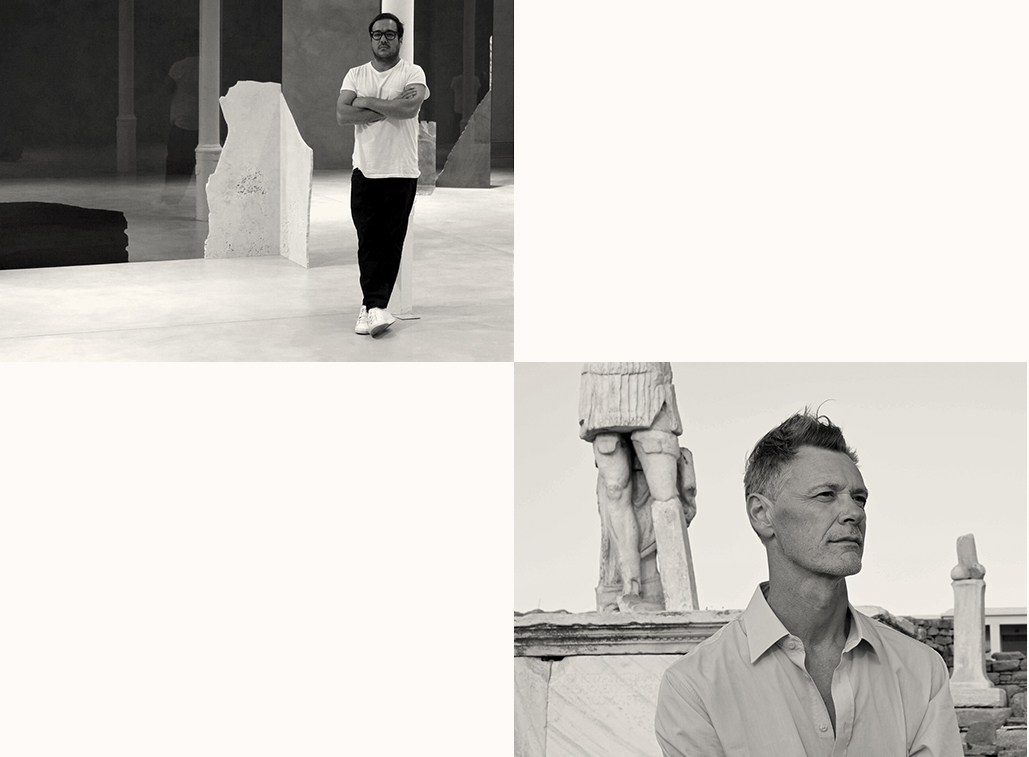



 Share this on LinkedIn, Twitter
Share this on LinkedIn, Twitter